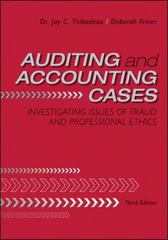Because the financial statements for the years 1993 through 1996 were not presented in conformity with Generally
Question:
Because the financial statements for the years 1993 through 1996 were not presented in conformity with Generally Accepted Accounting Principles (GAAP), Waste Management’s independent auditor, Arthur Andersen, came under scrutiny for issuing unqualified opinions on the financial statements for these years. The SEC filed suit against Andersen on charges that it knowingly or recklessly issued materially false and misleading audit reports for the period 1993 through 1996. Andersen ultimately settled with the SEC for \($7\) million, the largest ever civil penalty at the time, without admitting or denying any allegations or to earn additional fees for “special work.” Between 1991 and 1997, Andersen billed Waste Management approximately \($7.5\) million in financial statement audit fees.4 During this seven-year period, Andersen also billed Waste Management \($11.8\) million in fees related to other professional services.5 During the 1990s approximately 14 former Andersen employees worked for Waste Management.6 While at Andersen, most of these individuals worked in the group responsible for auditing Waste Management’s financial statements prior to 1991, and all but a few had left Andersen more than 10 years before the 1993 financial statement audit began.7 In fact, until 1997 every chief financial officer (CFO) and chief accounting officer (CAO) at Waste Management since it became public had previously worked as an auditor at Andersen. Waste Management’s CAO and corporate controller from September 1990 to October 1997, Thomas Hau, was a former Andersen audit engagement partner for the Waste Management account. When Hau left Andersen, he was the head of the division within Andersen responsible for conducting Waste Management’s annual audit, but he was not the engagement partner at that time.8 Andersen’s Partners on the Waste Management Audit In 1991 Andersen assigned Robert Allgyer, a partner at Andersen since 1976, to become the audit engagement partner for the Waste Management audit.
Allgyer held the title of partner-in-charge of client service, and he also served as the marketing director for Andersen’s Chicago office. Among the reasons for Allgyer’s selection as engagement partner were his “extensive experience in Europe,” his “devotion to client service,” and his “personal style that . . . fit well with the Waste Management officers.”9 In setting Allgyer’s compensation,............
Case Questions
1. What is auditor independence, and what is its significance to the audit profession? In what ways, if any, was Arthur Andersen’s independence potentially impacted on the Waste Management audit?
2. Considering the example in the Waste Management case, explain why a review by the practice director and the audit division head is important in the operations of a CPA firm. In your opinion, was this review effective at Waste Management? Why or why not?
3. What is meant by an auditor’s proposed adjusting journal entries (PAJEs)? Do you believe that Andersen’s final decision regarding the PAJEs was appropriate under the circumstances? Would your opinion change if you knew that all of the adjustments were based on subjective differences (such as a difference in the estimate of the allowance for doubtful accounts) as compared to objective differences (such as a difference in the accounts receivable balance of the biggest customer)?
4. How would these sections of the law have impacted the Waste Management audit? Do you believe that these sections were needed? Why or why not?
Step by Step Answer:

Auditing And Accounting Cases Investigating Issues Of Fraud And Professional Ethics
ISBN: 9780078110818
3rd Edition
Authors: Jay Thibodeau, Deborah Freier





